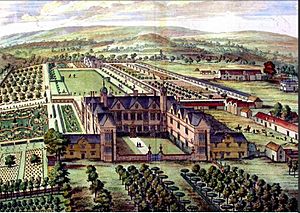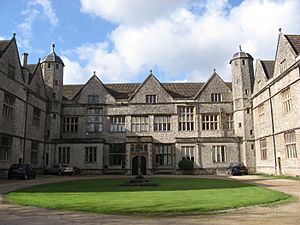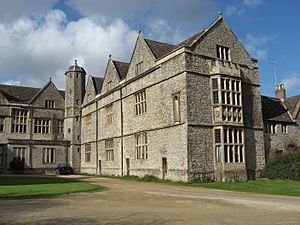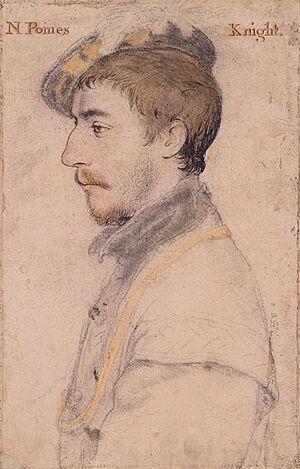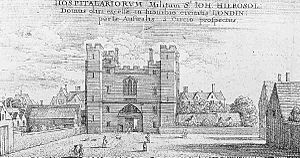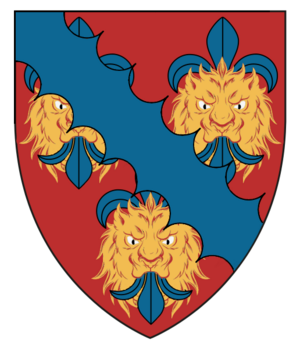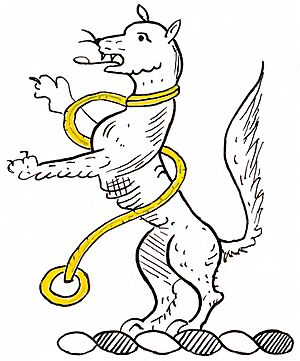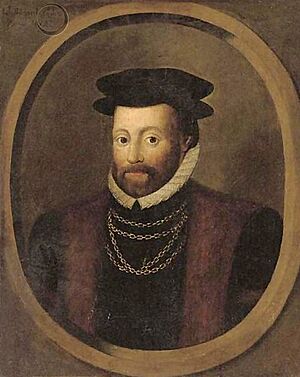Maurice Denys facts for kids
Sir Maurice Denys (born 1516, died 1563) was an important English lawyer and businessman. He lived at Siston Court near Bristol, and also in Clerkenwell, Middlesex. During a time when many monasteries were being closed down by the King, he was a powerful person at the "Court of Augmentations," which handled the money from these changes. He also served as a Member of Parliament for Malmesbury and was the Treasurer of Calais. Sir Maurice Denys built Siston Court in Gloucestershire, which still stands today. However, he borrowed and spent too much money, which caused financial problems for his family later on.
Contents
Early Life and Family History
Maurice Denys was the second son of Sir William Denys (who died in 1533). His father was a courtier, meaning he worked for King Henry VIII. Maurice's mother was Anne Berkeley. His family had lived in Gloucestershire for a long time, ever since his great-grandfather, Sir Gilbert Denys, settled there in 1379.
Becoming a Lawyer
Denys studied to become a barrister at the Inner Temple in London. He held several important positions there, like Marshal and Steward.
In 1537, King Henry VIII gave Denys a special job: he became the Receiver for the Order of Saint John. This religious order had been closed down in England during the time of the Dissolution of the Monasteries. This was a big job, possibly because his older brother, Sir Walter Denys, was married to Margaret Weston, whose uncle was the last leader of the Order before it closed. Denys lived at St John's Gate, Clerkenwell, which used to be the Order's main office. He also lived at St John's Jerusalem in Kent. He managed the Order's money until 1544.
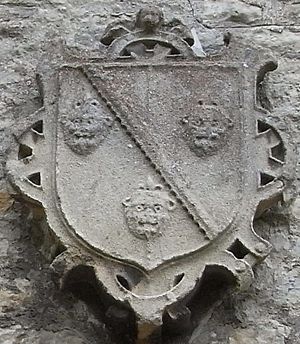
Later, Denys bought the family estate of Siston from his older brother, Sir Walter. This was around 1542. One of the brothers then built a new country house there, which became known as Siston Court.
Siston Court was built around the same time that other relatives of Denys were also building large homes nearby in Gloucestershire. Denys borrowed a lot of money to buy Siston and other estates, including parts of Kingswood Forest and the areas of Abson and Pucklechurch.
Marriage and New Connections
On February 3, 1545, Denys married Elizabeth Statham (who died in 1572). She was a widow whose first husband, Nicholas Statham, had been a member of the Worshipful Company of Mercers, a powerful trade group. Elizabeth was a strong supporter of the new Protestant religion. She even hosted important Protestant leaders at her home.
Before her marriage to Denys, Elizabeth had bought land in Great Sankey, Cheshire. After they married, Maurice and Elizabeth sold these lands to Maurice's brother-in-law, Walter Buckler.
Becoming a Knight and Member of Parliament
On February 22, 1547, just two days after King Edward VI became king, Maurice Denys was made a knight. In the same year, he became a Justice of the Peace for Gloucestershire and Kent. He was also elected to the House of Commons as a Member of Parliament for Malmesbury in Wiltshire.
Also in 1547, he sold some of his land in Clerkenwell to Sir Edward North. Sir Edward had bought the nearby London Charterhouse and made it his London home.
Treasurer of Calais
In December 1548, Denys was given the important job of Treasurer of Calais. Calais was an English territory in France at the time. This job required him to live there, and it was a difficult role because there was often not enough money. Being appointed Treasurer showed that the King trusted him greatly. In February 1551, he was granted a pension of £150 a year for life.
Financial Troubles
In June 1552, officials were sent to check Denys's accounts. They wanted to know what happened to money he claimed he hadn't received. In November, he was called back to England and put in the Fleet Prison. He was released, but then imprisoned again in September.
By this time, Denys's many land purchases were causing him serious financial problems. He had borrowed too much money. He had to sell several estates, probably to pay off debts from his time as Treasurer of Calais. Even Siston Court was mortgaged, meaning he had borrowed money against it.
Under Queen Mary I
On November 18, 1554, under Queen Mary I, Denys was asked to help welcome Cardinal Pole back to England. Cardinal Pole had been in exile and was returning to help Queen Mary bring England back to the Catholic Church. Denys did not have other government jobs under Queen Mary, possibly because of his debts and his religious beliefs.
In August 1556, Denys failed to make two payments to the Crown, so he had to promise his manor of Burton in Gloucestershire as security. In February 1557, he sold other estates around Bristol.
However, Queen Elizabeth I pardoned him in January 1559, and he began to restart his career.
Death and Legacy
In November 1562, Denys was in Portsmouth to pay soldiers. He died there on August 25, 1563, likely from the plague, which was common at the time.
When he died, Denys owed a large sum of £7,500 to the Crown. His nephew, Richard Denys, inherited his remaining estates, including Siston. However, Richard also inherited the huge debt. Richard tried to deal with the debt and keep Siston, but he faced many difficulties. Siston was eventually sold to Richard Wyke, and later to Sir Henry Billingsley.


